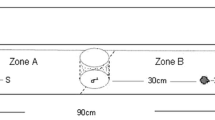Abstract
The efficiency of oesophagus and stomach temperature loggers to detect ingestion of prey items was studied in captive Adélie penguins (Pygoscelis adeliae) fed on land in Antarctica and in an aquarium in Japan. On land, the detection rate was studied for different masses of prey delivered at various frequencies, while in the pool the delay between capture and swallowing was investigated. The rate at which food items were detected and the magnitude of the temperature drops induced were higher in the oesophagus than in the stomach. Where small food items were delivered at a high frequency, birds collected prey items in the beak before swallowing them. Thus, oesophagus sensors may underestimate the number of prey swallowed if the system is used in the wild. In the oesophagus temperature recordings, the magnitude of drops was weakly, but positively, correlated to the mass of single, ingested prey (R 2=0.40).
Similar content being viewed by others
Author information
Authors and Affiliations
Additional information
Received: 24 April 2000 / Accepted: 20 September 2000
Rights and permissions
About this article
Cite this article
Ropert-Coudert, Y., Baudat, J., Kurita, M. et al. Validation of oesophagus temperature recording for detection of prey ingestion on captive Adélie penguins (Pygoscelis adeliae). Marine Biology 137, 1105–1110 (2000). https://doi.org/10.1007/s002270000414
Issue Date:
DOI: https://doi.org/10.1007/s002270000414




